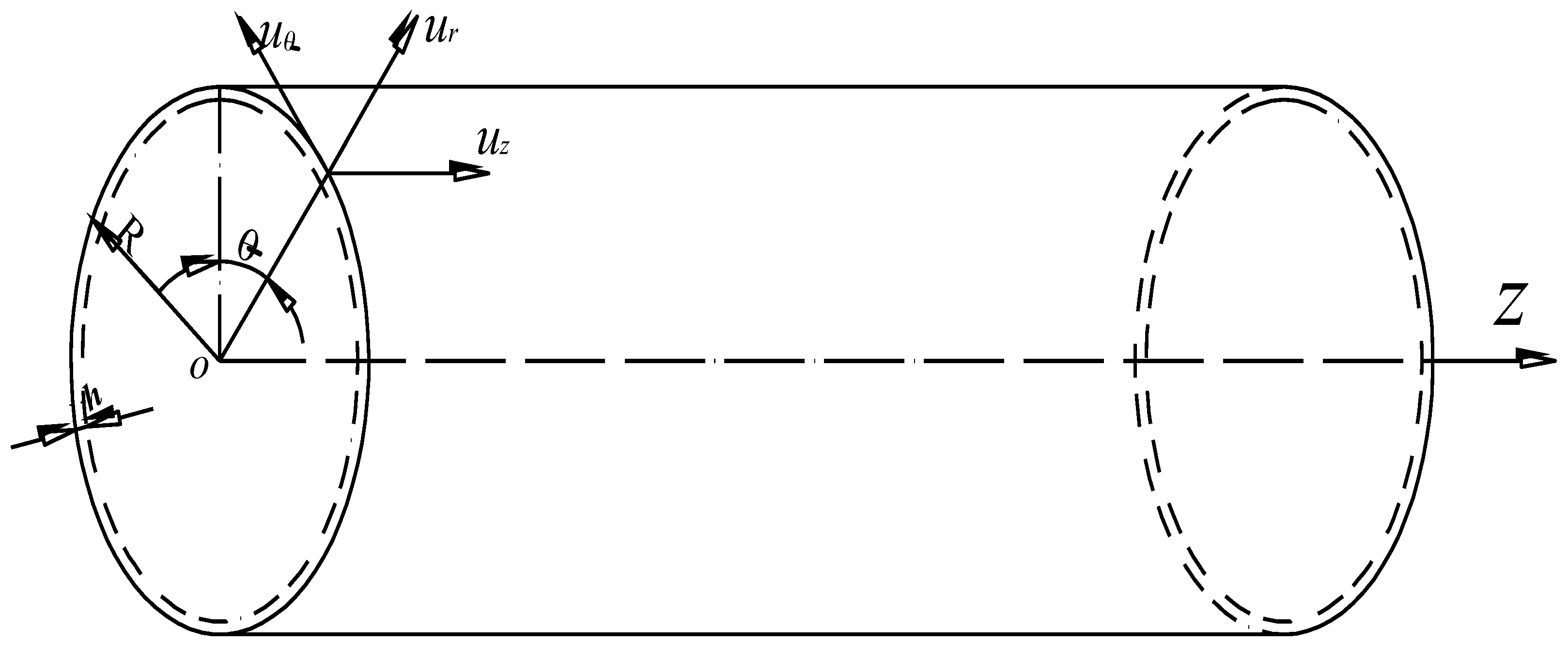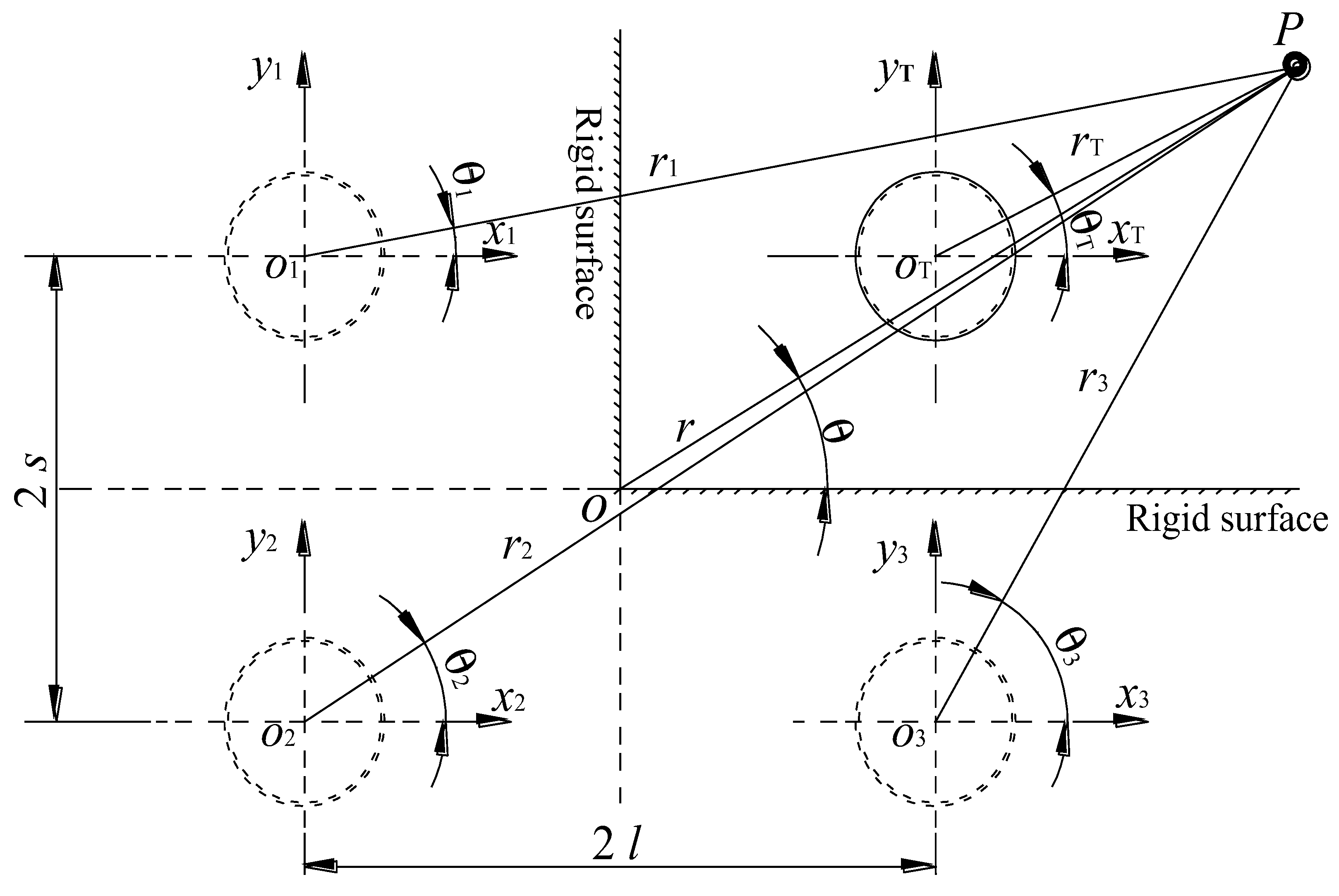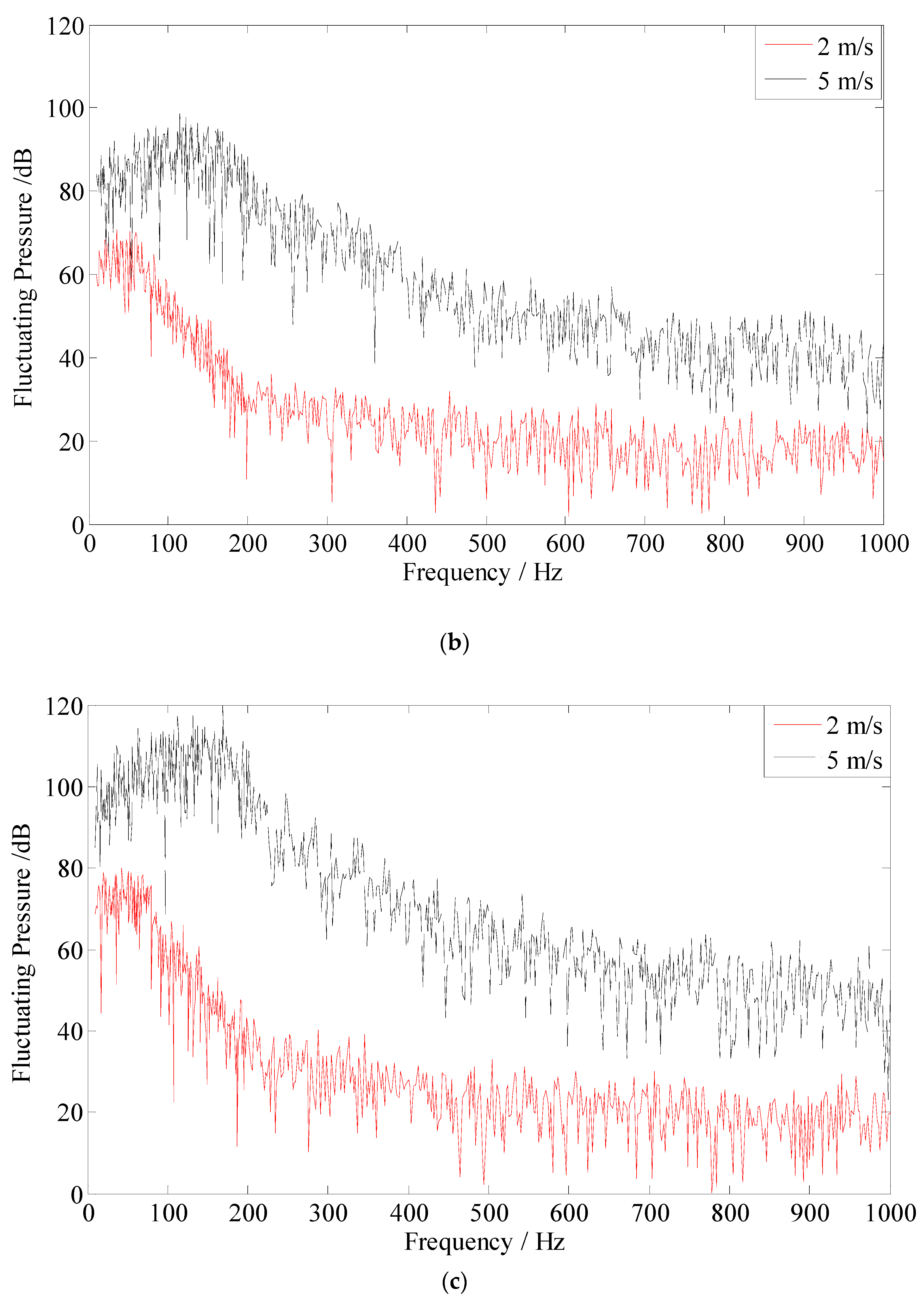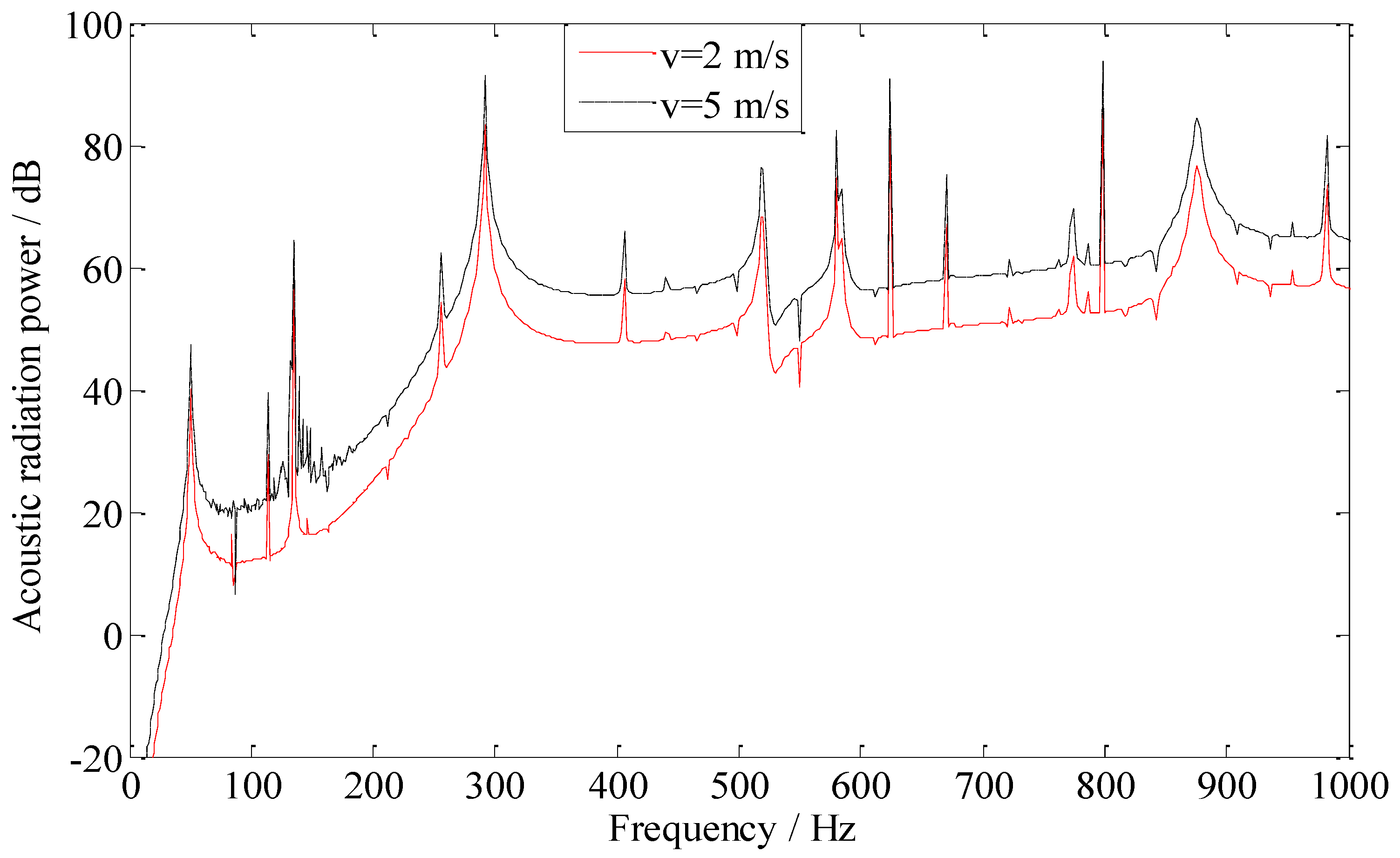Flow-Induced Noise Characteristics Analysis of a Pipeline Structure in a Cabin Rigid Corner
Abstract
1. Introduction
2. Flow Excitation Equation for Piping System
2.1. Pipeline Fluctuation Pressure
2.2. Stochastic Acoustic Vibration Analysis of the Piping System
3. The Acoustic Radiation Equation of the Pipeline Structure in a Rigid Corner
3.1. Cylindrical Shell Model
3.2. Corner Space Overview
3.3. Double-Reflection Theory
4. Numerical Calculation
4.1. Model Description
4.2. Fluctuation Pressure Calculation
4.3. Pipeline Acoustic Radiation Analysis
4.4. Acoustic Boundary Condition Influence Analysis
5. Conclusions
Author Contributions
Funding
Institutional Review Board Statement
Informed Consent Statement
Data Availability Statement
Conflicts of Interest
References
- Ke, B.; Xie, Z. A review of acoustical design technologies for shipboard piping system. Chin. J. Ship Res. 2008, 3, 57–63. (In Chinese) [Google Scholar]
- Ke, B. Influence factors analysis of flow-induced vibration of elbow in piping system. Chin. J. Ship Res. 2018, 13, 70–75. (In Chinese) [Google Scholar]
- Huang, J.F.; Chen, G.H.; Shu, L.; Shu, L.; Chen, Y.F.; Zhang, Y.E. Impact of fouling on flow-Induced vibration characteristics in fluid conveying pipelines. IEEE Access 2016, 4, 6530–6544. [Google Scholar] [CrossRef]
- Cao, Y.P.; Ke, H.B.; Lin, Y.S.; Zeng, M.; Wang, Q.W. Investigation on the flow noise propagation mechanism in simple expansion pipelines based on synergy principle of flow and sound fields. Energy Procedia 2017, 142, 3870–3875. [Google Scholar] [CrossRef]
- Zhang, T.; Zhang, Y.O.; Ouyang, H. Structural vibration and fluid-borne noise induced by turbulent flow through a 90° piping elbow with/without a guide vane. Int. J. Press. Vessel. Pip. 2015, 125, 66–77. [Google Scholar] [CrossRef]
- Wang, T.; Tang, K.; Zhang, Q.; Niu, D. Numerical simulation of flow-induced vibration and noise in nuclear power plant pipelines. Chin. J. Hydrodyn. 2021, 36, 56–66. (In Chinese) [Google Scholar]
- Cai, B.; Fang, C.; Ma, S.; Yu, J. Numerical simulation study on flow induced vibration noise of ship water injection pipeline based on fluid structure interaction. Ship Sci. Technol. 2020, 42, 118–122. (In Chinese) [Google Scholar]
- Droubi, M.G.; Reuben, R.L.; Steel, J.I. Flow noise identification using acoustic emission (AE) energy decomposition for sand monitoring in flow pipeline. Appl. Acoust. 2018, 131, 5–15. [Google Scholar] [CrossRef]
- Liu, G.; Zhang, K.; Lin, S. Study on flow-Induced vibration for pipe conveying fluid based on two way coupling method with CFD and FEM. Nucl. Power Eng. 2016, 37, 24–27. (In Chinese) [Google Scholar]
- Guo, T.; Zhang, T.; Zhao, W. Flow-induced vibration analysis of straight pipe based on LES. Eng. Mech. 2012, 19, 340–346. (In Chinese) [Google Scholar]
- Corcos, G.M. The structure of the turbulent pressure field in boundary-layer flows. J. Fluid Mech. 1964, 18, 353–378. [Google Scholar] [CrossRef]
- Chase, D.M. The wave-vector-frequency spectrum of pressure on a smooth plane in turbulent boundary-layer flow at low Mach number. J. Acoust. Soc. Am. 1991, 90, 1032–1040. [Google Scholar] [CrossRef]
- Bhushan, S.; Alam, M.F.; Walters, D.K. Evaluation of hybrid RANS/LES models for prediction of flow around surface combatant and Suboff geometries. Comput. Fluids 2013, 88, 834–849. [Google Scholar] [CrossRef]
- Zhang, X.; Zhang, N.; Wu, B. Computation of tunnel wall pressure fluctuations using large eddy simulation. J. Ship Mech. 2014, 18, 1153–1164. (In Chinese) [Google Scholar]
- Xu, J.; Mei, Z.; Li, H.; Zhou, Z. Vbration & acoustic response characteristics of a stiffened plate stimulated by turbulent boundary layer wall pressure fluctuation. J. Vib. Shock. 2020, 39, 156–163. (In Chinese) [Google Scholar]
- Li, Z.; Chen, M. Numerical method for calculating sound radiation characteristics of plate structure excited by TBL. Chin. J. Ship Res. 2017, 12, 76–82. (In Chinese) [Google Scholar]
- Karimi, M.; Maxit, L.; Croaker, P.; Robin, O.; Skvortsov, A.; Marburg, S.; Atalla, N.; Kessissoglou, N. Analytical and numerical prediction of acoustic radiation from a panel under turbulent boundary layer excitation. J. Sound Vib. 2020, 479, 115372. [Google Scholar] [CrossRef]
- Zou, Y.; Zhao, D.; Li, S. Impact of soft surface and hard plane on structural vibration and acoustic radiation. ACTA Acust. 2005, 30, 89–96. (In Chinese) [Google Scholar]
- Bapat, M.; Shen, S.L.; Liu, J.Y. Adaptive fast multipole boundary element method for three-dimensional half-space acoustic wave problems. Eng. Anal. Bound. Elem. 2009, 33, 1113–1123. [Google Scholar] [CrossRef]
- Chan, K.L.; Smith, B.; Wester, E. Flexural wave scattering in a quarter-infinite thin plate with circular scatterers. Int. J. Solids Struct. 2009, 46, 3669–3676. [Google Scholar] [CrossRef][Green Version]
- Chen, L.Y.; Liang, X.F.; Yi, H. Vibro-acoustic characteristics of cylindrical shells with complex acoustic boundary conditions. Ocean. Eng. 2016, 126, 12–21. [Google Scholar] [CrossRef]
- Chen, L.Y.; Liu, Y. Analysis of the input power flow characteristics of cylindrical shells with combination boundaries. J. Low Freq. Noise Vib. Act. Control. 2019, 38, 93–109. [Google Scholar] [CrossRef]
- Weng, L.; Miao, Y.; Li, T. Acoustic and vibration characteristics of underwater cylindrical shell with complex acoustic boundaries. J. Vib. Shock. 2019, 38, 186–193. (In Chinese) [Google Scholar]
- Guo, W.J.; Li, T.Y.; Zhu, X.; Miao, Y.Y. Sound-structure interaction analysis of an infinite-long cylindrical shell submerged in a quarter water domain and subject to a line-distributed harmonic excitation. J. Sound Vib. 2018, 422, 48–61. [Google Scholar] [CrossRef]









| 2 (m/s) | 5 (m/s) | |||||
|---|---|---|---|---|---|---|
| 10–200 Hz | 200–1000 Hz | 10–1000 Hz | 10–200 Hz | 200–1000 Hz | 10–1000 Hz | |
| l = 0, s = 0 | 54.92 | 79.82 | 79.84 | 62.18 | 87.82 | 87.83 |
| l = 0.25, s = 0.25 | 60.10 | 86.45 | 86.46 | 67.65 | 94.46 | 94.47 |
| l = 0.25, s = 1.0 | 65.51 | 86.14 | 86.17 | 72.82 | 94.14 | 94.17 |
| l = 1.0, s = 1.0 | 62.20 | 85.89 | 85.91 | 69.26 | 93.88 | 93.90 |
Disclaimer/Publisher’s Note: The statements, opinions and data contained in all publications are solely those of the individual author(s) and contributor(s) and not of MDPI and/or the editor(s). MDPI and/or the editor(s) disclaim responsibility for any injury to people or property resulting from any ideas, methods, instructions or products referred to in the content. |
© 2023 by the authors. Licensee MDPI, Basel, Switzerland. This article is an open access article distributed under the terms and conditions of the Creative Commons Attribution (CC BY) license (https://creativecommons.org/licenses/by/4.0/).
Share and Cite
Chen, W.; Chen, L.; Yi, H.; Dong, J. Flow-Induced Noise Characteristics Analysis of a Pipeline Structure in a Cabin Rigid Corner. Appl. Sci. 2023, 13, 11772. https://doi.org/10.3390/app132111772
Chen W, Chen L, Yi H, Dong J. Flow-Induced Noise Characteristics Analysis of a Pipeline Structure in a Cabin Rigid Corner. Applied Sciences. 2023; 13(21):11772. https://doi.org/10.3390/app132111772
Chicago/Turabian StyleChen, Weihua, Luyun Chen, Hong Yi, and Jianshuai Dong. 2023. "Flow-Induced Noise Characteristics Analysis of a Pipeline Structure in a Cabin Rigid Corner" Applied Sciences 13, no. 21: 11772. https://doi.org/10.3390/app132111772
APA StyleChen, W., Chen, L., Yi, H., & Dong, J. (2023). Flow-Induced Noise Characteristics Analysis of a Pipeline Structure in a Cabin Rigid Corner. Applied Sciences, 13(21), 11772. https://doi.org/10.3390/app132111772






